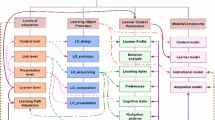Abstract
How learners can build their own knowledge, which is precisely tailored to their needs and background? This is precisely the question to which this paper attempts to answer by providing a framework for a flexible object-based e-learning environment. The paper recognizes that the general learner modeling alternative is an intractable problem. However, it suggests learning objects construct used as building blocks to root out individual learning deficiencies. The paper also provides an algorithm to construct individual learning routes that are adjusted to learners' profile as well as an open implementation to accommodate the integration of various learning sources.
Similar content being viewed by others
References
Advanced Distributed Learning – SCORM, Version 1.2 (2001); www.adlnet.org
Atif, Y. (2001) Real-time network resources allocation in distributed multimedia information systems. In Proc. of IEEE GLOBCOM, San Antonio, Texas, USA.
Bannan-Ritland, B., Dabbagh, N., and Murphy, K. (2001) Learning object systems as constructivist learning environments: Related assumptions, theories and applications. In The Instructional Use of Learning Objects, D. A. Wiley (ed.). Association for Educational Communications and Technology, Bloomington, IN.
Boys, G. A. (1997) Software agents for cooperative learning. In Software Agent, J. M. Bradshaw (ed.). AAAI Press/MIT Press.
Cheikes, B. A. (1995) GIA: An agent based architecture for intelligent tutoring systems. In Proceedings of CIKM Workshop on Intelligent Information Agents, Baltimore, MA.
Dale, N. and Teague, D. (2001) C++ Plus Data Structures (2nd edition), Jones and Barlett (eds.).
Duffy, T. M. and Jonassen, D. H. (1991) Constructivism: New implications for educational technology. Educational Technology, 31(5), 7–12.
Dufresne, A. (2000) Model of an adaptive support interface for distance learning. In Proceedings of the 5th International Conference on Intelligent Tutoring Systems ITS'2000, Montreal, Canada, June, pp. 334–343.
El-Khouly, M. M., Far, B. H., and Koono, Z. (1999) A multiagent Internet based tutoring system (I-CALT) for teaching computer programming languages. In Advanced Research in Computers and Communication in Education, G. Cummings et al. (eds.). IOS Press.
Fung A. C. W. and Yeung, J. C. F. (2000) An object model for a web-based adaptive educational system. In Proceedings of the IFIP International Conference on Educational Use of Technologies (ICEUT'2000), China, August.
Gibbons, A. S., Nelson, J., and Richards, R. (2001) The nature and origin of instructional objects. In The Instructional Use of Learning Objects, D. A. Wiley (ed.). Association for Educational Communications and Technology, Bloomington, IN.
Harmse, R. and Thomas, T. (2001) Towards a conceptual UML model for tracking a learner's progress in an outcomes-based environment. In Proceedings of the South African Institute of Computer Scientists and Information Technologists Annual Conference, Pretoria, South Africa, September, pp. 57–65.
IMS Global Learning Consortium. (2001) IMS Content Packaging Specification; http://www.imsproject.org/ content/packaging/index.html
IMS Global Learning Consortium. (2003a) IMS Learner Information Package Specification; http://www. imsglobal.org/profiles/index.html
IMS Global Learning Consortium. (2003b) IMS Learning Resource Meta-Data Information Model, Version 1.2.2; http://www.imsglobal.org/metadata/imsmdv1p2p2/imsmd_infov1p2p2.html
Lieberman, H. (1993) Mondrian: A teachable graphical editor. In Watch what I Do: Programming by Demonstration, A. Cypher (ed.). MIT Press.
LTSC. (2000) Learning technology standards committee. http://ltsc.ieee.org/ LTSC/IEEE LOM specification, IEEE 1484.12/D6.1 (May 2001). Available at: http://ltsc.ieee.org/doc/wg12/ LOM-WD6-1-1.pdf
Maes, P. et al. (1996) The ALIVE system: Wirelless, full body interaction with autonomous agents. ACM– Springer Multimedia Systems, Special Issue on Multimedia and Multisensory Virtual Worlds. Springer.
Manouselis, N. and Sampson, D. (2002) Dynamic knowledge route selection for personalised learning environments using multiple criteria. In Proceedings of the IASTED International Conference on Applied Informatics, February, pp. 351–605.
Maulsby, D. (1993) The turvy experience: Simulating an instructible interface. InWatch what I Do: Programming by Demonstration, A. Cypher (ed.). MIT Press.
Najjar, L. J. (1996) Multimedia information and learning. Journal of Educational Multimedia and Hypermedia, 5, 129–150.
Patel, A. and Kinshuk, K. (1998) Discipline attributes and teaching styles: Environmental context of an its design for determining multimedia and virtual reality representations. Knowledge Transfer, 1(1), 107–113.
Rickel, J. and Johnson, W. (1998) STEVE: A pedagogical agent for virtual reality. In Proceedings of the 2nd ACM International Conference on Autonomous Agents, Minneapolis, USA.
Rodriguez, O. et al. (2002) Open learning objects: The case of inner metadata. In Proceedings of the 11th World Wide Web Conference – WWW'2002, Honolulu, May.
Teixeira, C., Labidi, S., and Nascimento, E. (2002) Modeling the cooperative learner based on it's actions and interactions within a teaching-learning session. In Proceedings of the 32nd ASEE/IEEE Frontiers in Education Conference, Boston, USA, November, pp. 19–23.
Author information
Authors and Affiliations
Rights and permissions
About this article
Cite this article
Atif, Y., Benlamri, R. & Berri, J. Learning Objects Based Framework for Self-Adaptive Learning. Education and Information Technologies 8, 345–368 (2003). https://doi.org/10.1023/B:EAIT.0000008676.64018.af
Issue Date:
DOI: https://doi.org/10.1023/B:EAIT.0000008676.64018.af




